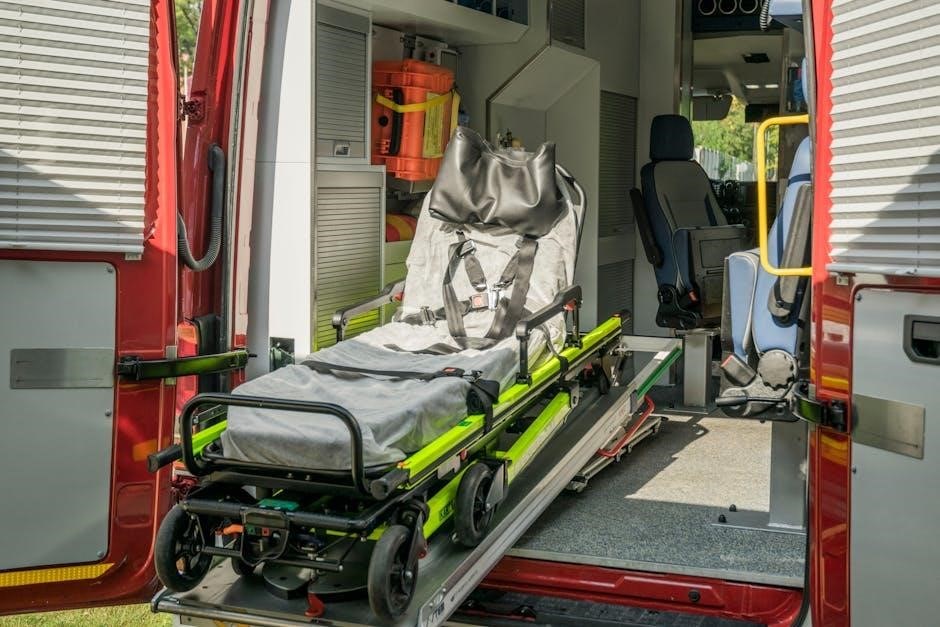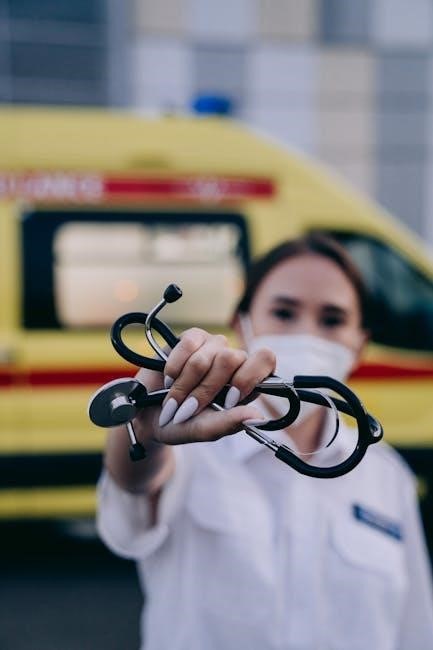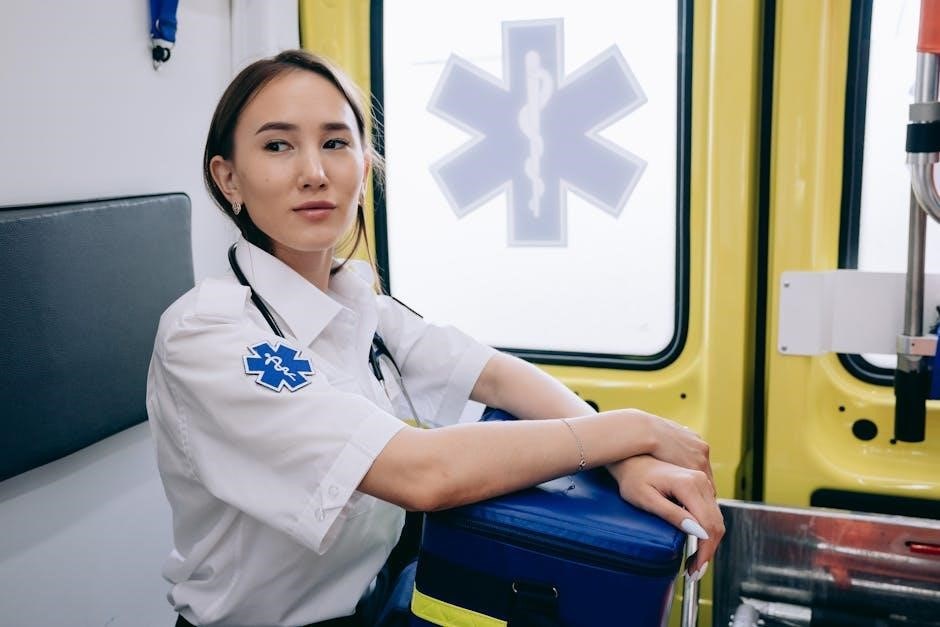First aid step 3 focuses on the three Ps: preserve life, prevent deterioration, and promote recovery. This step ensures immediate care to stabilize the victim’s condition effectively.
1.1 Understanding the Importance of First Aid Training
First aid training is crucial for saving lives and reducing recovery time. It equips individuals with the skills to respond confidently in emergencies. Proper techniques prevent further harm and promote recovery. The American Red Cross emphasizes its importance in their guidelines, ensuring effective care during crises. Timely intervention can significantly improve outcomes.
1.2 Overview of the Three Ps of First Aid
The Three Ps of first aid—Preserve, Prevent, and Promote—guide effective emergency response. Preserve life by addressing immediate threats, prevent further harm through proper techniques, and promote recovery by stabilizing the victim. These principles ensure a structured approach, enhancing the chances of a positive outcome and aligning with guidelines from organizations like the American Red Cross.
Assessing the Situation
Assessing the situation involves ensuring personal safety, identifying potential dangers, and evaluating the victim’s condition to provide appropriate care effectively in emergencies.
2.1 Ensuring Personal Safety
Ensuring personal safety is critical before assisting a victim. Check the environment for hazards, ensure your own safety, and avoid risks. Always prioritize your well-being to effectively help others. This step is vital to prevent further harm and allow you to provide care confidently and safely in emergency situations.
2.2 Identifying Potential Dangers in the Environment
Identify potential dangers in the environment, such as broken glass, fire, or unstable structures. Assess the scene for risks that could harm you or the victim. Ensure the area is safe before providing care. Recognizing these hazards helps prevent further incidents and allows for effective first aid administration.

The Primary Survey
The primary survey involves assessing the victim’s airway, breathing, and circulation (ABCs) and identifying signs of critical conditions to provide immediate, life-saving interventions.
3.1 Checking Airway, Breathing, and Circulation (ABCs)
Check the airway for obstructions and ensure it is clear. Assess breathing by listening for sounds and observing chest movements. Verify circulation by checking for a pulse and skin color changes. If absent, begin CPR immediately. Failure to address these can lead to organ damage or death, making prompt intervention critical in emergencies.
3.2 Identifying Signs of Critical Conditions
Recognizing critical conditions early is vital. Look for signs like unresponsiveness, abnormal breathing, or lack of a pulse. Severe injuries, bleeding, or shock indicators like pale skin or fainting require immediate action. Delaying recognition can lead to organ failure or death, making swift identification and intervention essential to improve survival chances and prevent further deterioration.
Providing Care
Administer first aid by addressing injuries, using a first aid kit, and providing comfort. Treat burns, control bleeding, and stabilize fractures to prevent further harm and promote recovery.
4.1 Administering First Aid for Common Injuries

For burns, cool the area with cool water for 10-15 minutes. Clean and bandage wounds to prevent infection. For fractures, immobilize with a splint and apply ice. Treat sprains with RICE (Rest, Ice, Compression, Elevation). Monitor for shock and provide reassurance. Always use sterile supplies from a first aid kit to ensure proper wound care and prevent further harm;
4.2 Using a First Aid Kit Effectively
A well-stocked first aid kit is essential for providing proper care. It should include bandages, antiseptic wipes, gloves, and a first aid manual; Always assess the situation before using supplies. Use items like bandages to stop bleeding and apply antiseptic wipes to prevent infection. Keep the kit organized and restock it regularly to ensure all items are available when needed. Proper use ensures effective treatment and safety.
The Three Cs of First Aid

The Three Cs of First Aid are Check, Call, and Care. These steps ensure a structured approach to providing effective assistance during emergencies, prioritizing victim safety and recovery.
5.1 Check the Scene and Victim
Checking the scene ensures personal safety and identifies potential dangers. Evaluate the environment for hazards, determine the number of victims, and assess their condition. Stay calm, approach systematically, and prioritize victim safety. This step is crucial for providing effective care without risking further harm to yourself or others. It sets the foundation for the next steps in first aid.
5.2 Call for Emergency Help
Calling for emergency help is critical when a life-threatening situation arises. Dial the local emergency number, such as 9-1-1, and provide clear, concise information. If alone, call first before providing care. Retrieve the AED and first aid kit if needed. Inform someone else to call if you’re unable to do so. Prompt action ensures professional help arrives quickly, improving the victim’s chances of recovery.
5.3 Provide Appropriate Care
After ensuring the scene is safe and calling for help, focus on providing care tailored to the victim’s condition. Administer first aid based on the primary survey, addressing airway, breathing, and circulation. Control bleeding, treat burns, or stabilize injuries as needed. Use the first aid kit effectively, monitoring the victim’s condition and providing reassurance. Avoid overstepping your training; stay with the victim until professional help arrives.

Personal Protective Equipment (PPE)
Wearing gloves is essential to protect against bodily fluids and pathogens. Properly remove contaminated gloves by turning them inside out to avoid exposure. Hand hygiene is critical.
6.1 Importance of Wearing Gloves
Wearing gloves in first aid is crucial for protecting against bodily fluids and pathogens. Gloves create a barrier, reducing the risk of infection transmission. They maintain hygiene standards and prevent cross-contamination. Always wear gloves when handling wounds, bodily fluids, or contaminated surfaces to ensure both rescuer and victim safety. This step is vital in maintaining a sterile environment during care.
6.2 Proper Technique for Removing Contaminated Gloves
Properly removing contaminated gloves prevents exposure to pathogens. Start with one glove, pulling it inside out while keeping it in the other gloved hand. Repeat with the second glove, turning it inside out to avoid touching the contaminated surface. Dispose of the gloves safely and wash hands immediately to maintain hygiene and prevent infection spread.

Promoting Recovery
Promoting recovery involves monitoring the victim’s condition, providing comfort, and reassurance. This step helps stabilize emotional and physical well-being, ensuring the victim remains calm and supported.
7.1 Monitoring the Victim’s Condition
Monitoring the victim’s condition involves observing vital signs, such as breathing and pulse, and checking for changes in responsiveness or injury severity. This step ensures timely adjustments to care and prevents further complications. Continuous observation helps identify any deteriorations early, allowing for prompt interventions to stabilize the victim until professional help arrives.
7.2 Providing Comfort and Reassurance
Providing comfort and reassurance involves staying calm, speaking softly, and explaining actions to reduce the victim’s anxiety. This emotional support helps maintain the victim’s confidence and cooperation during care. It is crucial to avoid causing unnecessary alarm while ensuring the victim feels safe and supported until professional help arrives.
Physical comfort, such as loosening tight clothing or adjusting position, can also aid in reducing discomfort and stress, promoting a more stable condition for recovery.

Secondary Survey and Ongoing Assessment
The secondary survey involves a thorough head-to-toe examination to identify injuries or conditions not apparent during the primary assessment. This step ensures ongoing monitoring and documentation.
8.1 Conducting a Head-to-Toe Examination
A head-to-toe examination involves systematically checking the victim from head to toe for injuries or abnormalities. Start with the head, noting signs of trauma, swelling, or bleeding. Assess the neck for deformities or difficulty breathing. Examine the chest for breathing patterns and rib injuries. Check the abdomen for tenderness or distension. Inspect arms and legs for fractures, wounds, or deformities. Note any signs of shock or distress. Document all findings to provide detailed information to medical professionals. This thorough assessment ensures no injuries are overlooked, promoting effective care and recovery. Always maintain patient comfort and reassurance during the process. This step is crucial for identifying less obvious injuries that may not have been apparent during the primary survey. Proper documentation aids in continuity of care, ensuring medical professionals receive comprehensive information upon arrival. Regular monitoring and reassessment are essential to detect any changes in the victim’s condition. By following this structured approach, first responders can deliver more accurate and timely care, improving patient outcomes significantly. The head-to-toe examination is a fundamental skill in first aid training, emphasizing the importance of meticulous observation and detailed reporting. It ensures that all aspects of the victim’s condition are evaluated, preventing potential oversights that could worsen their state. This methodical approach also helps in prioritizing care and managing resources effectively in emergency situations. Overall, a thorough head-to-toe examination is vital for providing appropriate and immediate assistance, aligning with the principles of preserve, prevent, and promote in first aid practices. The process underscores the need for continuous learning and adherence to updated guidelines, ensuring first responders are well-equipped to handle various emergencies with confidence and precision. By integrating this examination into first aid protocols, the quality of care delivered in critical moments is significantly enhanced, contributing to better recovery rates and patient well-being. The head-to-toe examination serves as a cornerstone in first aid training, reinforcing the importance of systematic assessment and thorough documentation. It highlights the role of first aid in bridging the gap between the incident and professional medical intervention, making it an indispensable skill for all individuals. The structured nature of this examination ensures consistency and reliability, allowing first responders to act efficiently even under pressure. This approach not only benefits the victim but also equips responders with the confidence to handle emergencies effectively, fostering a culture of preparedness and proactive care. In conclusion, the head-to-toe examination is an integral component of first aid step 3, illustrating the comprehensive nature of care required to address all aspects of a victim’s condition promptly and accurately.
8.2 Documenting Findings for Medical Professionals
Accurate documentation of findings ensures continuity of care and aids medical professionals in understanding the situation. Record the victim’s condition, injuries, and treatments administered. Note vital signs, visible wounds, and any changes observed. This detailed information helps medical teams make informed decisions quickly. Proper documentation also serves as a reference for further treatment, ensuring seamless care transition. Always maintain clarity and precision in records to avoid misunderstandings. This step is critical for effective communication between first responders and healthcare providers, ultimately improving patient outcomes. By documenting thoroughly, first aiders contribute to a well-coordinated care process, aligning with the principles of first aid. Regular updates in documentation are essential, especially if the victim’s condition evolves. This practice not only enhances care quality but also demonstrates accountability in emergency response situations. Documenting findings is a vital skill emphasized in first aid training, ensuring that all critical details are captured and conveyed effectively. It underscores the importance of attention to detail and clear communication in life-saving scenarios. Through accurate records, first responders play a pivotal role in the victim’s recovery journey, highlighting the significance of documentation in first aid practices. This systematic approach ensures that no crucial information is overlooked, fostering a collaborative effort between first aiders and medical professionals. By adhering to documentation protocols, responders uphold the standards of care expected in emergency situations. This step reinforces the value of meticulous record-keeping in achieving optimal patient outcomes and supporting the broader healthcare system.
Hand Hygiene and Infection Control
Hand hygiene is crucial in first aid. Use soap, water, or sanitizer. Wear gloves to prevent infection spread and maintain cleanliness during care.
9.1 Preventing the Spread of Infections
Preventing infection spread is vital in first aid. Always wear gloves to avoid direct contact with bodily fluids. Wash hands thoroughly with soap and water or use hand sanitizer after removing gloves. Properly dispose of contaminated materials and clean surfaces with disinfectants; Avoid touching your face to prevent cross-contamination. These steps ensure a safe environment for both the victim and the first aider.
9.2 Proper Handwashing Techniques
Proper handwashing is essential for infection control. Wet hands with clean water, apply soap, and scrub all surfaces for 20 seconds, including between fingers and under nails. Rinse thoroughly under running water, then dry completely with a clean towel or air dryer. If water is unavailable, use hand sanitizer with at least 60% alcohol, covering all hand surfaces and rubbing until dry. This ensures effective hygiene and prevents germ spread.
First aid is crucial for saving lives and preventing further harm. Continuous learning and practice ensure readiness in emergencies, making it a vital skill for everyone.
10.1 The Role of First Aid in Saving Lives
First aid acts as a critical bridge between the onset of an emergency and professional medical help. It preserves life by addressing airway, breathing, and circulation issues. Immediate care prevents deterioration, such as controlling bleeding or managing shock. By stabilizing the victim, first aid buys time for recovery, reducing long-term damage. It empowers individuals to act confidently, saving lives and improving outcomes.
10.2 Encouraging Continuous Learning and Practice
Continuous learning and practice are vital for mastering first aid skills. Regular training updates ensure knowledge aligns with the latest guidelines. Practical exercises build confidence and preparedness. Encouraging community engagement and refresher courses fosters a culture of safety and readiness. Staying informed and skilled empowers individuals to respond effectively, saving lives and improving outcomes in emergencies.
